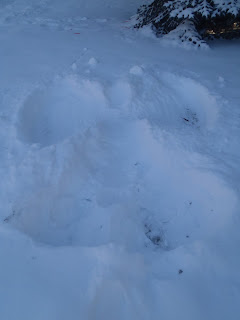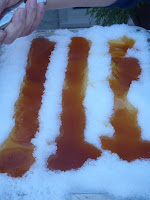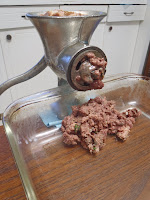 Button Soup Advent Calendar: Conclusion
Button Soup Advent Calendar: ConclusionI meant to start my series of Christmas posts with some general thoughts on what Christmas food means to me. When I sat down to write that post, I faltered, and decided to jump right into the specific preparations. Now that I have worked through several dishes and had some time to reflect, I have some thoughts to share.
Christmas food is interesting to me because few ingredients are "in season" in the normal sense. Unlike, say, Thanksgiving, Christmas is a celebration that ironically takes place during scarcity. The food relies heavily on preserved ingredients such as dried fruit, candied fruit, dried mushrooms, cured meat, and baked goods high in fat and sugar. Along the same lines, there are lots of aged items, notably fruitcake, rumpot, and wine.
Because of the bleak winter landscape, Christmas meals are informed by tradition more than conventional seasonality. While dandelions and asparagus are associated with springtime simply because that's when they grow, Christmas ingredients are often rooted in history and culture. Turkey, for instance, or exotic ingredients like dates, ginger, cloves, and cinnamon.
While I have a reverence for those imported tastes and aromas, I also tried using neglected local flavours like juniper and evergreen. Smoking with evergreen especially is something I enjoyed. The idea of "eating my Christmas tree" excites me. (On a related note, this was the first year that I ate my jack o' lantern, roasting him after the trick-or-treaters had stopped calling.)
I didn't say it specifically, but the Christmas posts were in three sections: drink, sweets, and meats. To me those groups form the core of festive food, generally, and Christmas food, specifically.
-
This happens to be my one hundredth post, and the close of what I consider the first chapter of Button Soup. I have new plans for the coming year. Stay tuned.




















 Candied peel is dead simple to make. Remove the peel from lemons and oranges. Use proper, thick-skinned oranges like navel, not thin-skinned mandarins. Cut into strips.
Candied peel is dead simple to make. Remove the peel from lemons and oranges. Use proper, thick-skinned oranges like navel, not thin-skinned mandarins. Cut into strips.



















 Heating the syrup to 235°F will yield a sticky, slightly runny though still manageable taffy. I like this stage because it is a little messy. Higher temperatures yield firmer taffies.
Heating the syrup to 235°F will yield a sticky, slightly runny though still manageable taffy. I like this stage because it is a little messy. Higher temperatures yield firmer taffies. 








